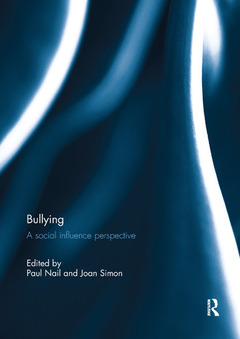Description
Bullying
A Social Influence Perspective
Coordinators: Nail Paul, Simon Joan
Language: English
Subject for Bullying:
Keywords
Bullying Victimization; adolescence; Group Norm; behavioural psychology; De Sc Rip; bullying; Computer Mediated Communication; cyber-bullying; Low Stable Group; developmental psychology; Norm Misperception; intervention programs; Bullying Targets; school counselling; Victimization Trajectories; social networks; Trajectory Groups; suicide; Minimum BIC; victimization; Traditional Bullying; Bullying Episodes; Proactive Aggression; Health Promotion Research Centre; Prosocial Attitudes; Smart Phones; Poorer Mental Health Outcomes; Support Victims; USA 2Department; Social Influence Perspective; Children’s Behavioral Responses; Compliance Scale; Exclusion Manipulation; Relational Aggression; Workplace Ostracism
Publication date: 06-2017
· 17.4x24.6 cm · Paperback
Publication date: 07-2015
· 17.4x24.6 cm · Hardback
Description
/li>Contents
/li>Readership
/li>Biography
/li>
There was a time when bullying was regarded as a relatively innocuous issue?a normal part of growing up?but this is no longer the case. The magnitude of the problems that bullying can lead to is evidenced by the rising amount of professional literature on bullying, as well as recent cases of bully-linked suicide and homicide in the popular media. Bullying always involves at least one bully and one victim, but there are a variety of social roles that can affect the duration and magnitude of bullying. These roles include bully assistants or supporters, victim defenders, and passive bystanders. Fundamental to creating successful intervention programs to prevent or reduce bullying is basic research that identifies the characteristics of those involved in bullying situations (e.g., personality, motivational, intellectual, physical, social, and behavioural).
This volume presents a broad range of original research describing how social influences are related to bullying. Reflecting the fact that bullying is a world-wide phenomenon and problem, the research comes from samples of individuals from Australia, Finland, Italy, New England, and Poland, as well as a review of the cyber-bullying literature, which is international in scope. This book was originally published as a special issue of Social Influence.
1. Introduction: A social influence perspective2. Sticks and stones may break your bones, but words will always hurt you: A review of cyberbullying3. Developmental trajectories of adolescent victimization: Predictors and outcomes4. Does bullying increase compliance?5. Bullying the bully: Why zero-tolerance policies get a failing grade6. Friend similarity in attitudes toward bullying and sense of responsibility to intervene7. Overt and relational victimization and adolescent friendships: Selection, de-selection, and social influence8. Social context of bullying: Do misperceptions of group norms influence children’s responses to witnessed episodes?
Paul R. Nail is a Professor at the University of Central Arkansas, Conway, AR, USA. He holds a Ph.D. in experimental psychology from Texas Christian University, Fort Worth, TX, USA. Besides bullying, his research interests include social influence in groups, cognitive dissonance theory, contemporary theories of racism, political psychology, and individual differences in psychological defenses.
Joan B. Simon is an Associate Professor at the University of Central Arkansas, Conway, AR, USA. Her Ph.D. in school psychology is from the University of Kansas, Lawrence, KS, USA. She is a licensed psychologist whose work on behalf of children with severe emotional needs has been disseminated through professional presentations and publications.




